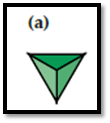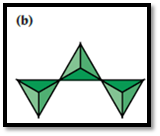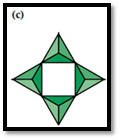
General Chemistry: Atoms First
2nd Edition
ISBN: 9780321809261
Author: John E. McMurry, Robert C. Fay
Publisher: Prentice Hall
expand_more
expand_more
format_list_bulleted
Concept explainers
Question
Chapter 19, Problem 19.19CP
(a)
Interpretation Introduction
Interpretation:
The formula of given silicate and charge of each anion has to be written.

Figure 1
(b)
Interpretation Introduction
Interpretation:
The formula of given silicate and charge of each anion has to be written.

Figure 3
(c)
Interpretation Introduction
Interpretation:
The formula of given silicate and charge of each anion has to be written.

Figure 5
Expert Solution & Answer
Want to see the full answer?
Check out a sample textbook solution
Students have asked these similar questions
7. Provide the product(s), starting material(s) and/or condition(s) required for the
No mechanisms required.
below reaction
HO
+ H-I
CI
FO
Br2, FeBr3
O
I-O
6. Design the most efficient synthesis of the following product starting from phenot
Provide the reaction conditions for each step (more than one step is required) and
explain the selectivity of each reaction. NO MECHANISMS ARE REQUIRED.
OH
step(s)
CI
What is the skeletal structure of the product of the following organic reaction?
Chapter 19 Solutions
General Chemistry: Atoms First
Ch. 19.1 - Prob. 19.1PCh. 19.2 - Prob. 19.2PCh. 19.2 - Prob. 19.3CPCh. 19.4 - Prob. 19.4PCh. 19.7 - Prob. 19.5PCh. 19.8 - Prob. 19.6CPCh. 19.10 - Prob. 19.7PCh. 19.13 - Prob. 19.8CPCh. 19.13 - Prob. 19.9PCh. 19.14 - Prob. 19.10P
Ch. 19 - Prob. 19.11CPCh. 19 - Prob. 19.12CPCh. 19 - Locate the following elements on the periodic...Ch. 19 - Prob. 19.14CPCh. 19 - Prob. 19.15CPCh. 19 - Prob. 19.16CPCh. 19 - Prob. 19.17CPCh. 19 - Prob. 19.18CPCh. 19 - Prob. 19.19CPCh. 19 - Prob. 19.20SPCh. 19 - Prob. 19.21SPCh. 19 - Prob. 19.22SPCh. 19 - Prob. 19.23SPCh. 19 - Prob. 19.24SPCh. 19 - Prob. 19.25SPCh. 19 - Prob. 19.26SPCh. 19 - Prob. 19.27SPCh. 19 - Prob. 19.28SPCh. 19 - Which compound in each of the following pairs is...Ch. 19 - Prob. 19.30SPCh. 19 - Prob. 19.31SPCh. 19 - Prob. 19.32SPCh. 19 - Prob. 19.33SPCh. 19 - Prob. 19.34SPCh. 19 - Prob. 19.35SPCh. 19 - Prob. 19.36SPCh. 19 - Prob. 19.37SPCh. 19 - Prob. 19.38SPCh. 19 - Prob. 19.39SPCh. 19 - Prob. 19.40SPCh. 19 - Prob. 19.41SPCh. 19 - Prob. 19.42SPCh. 19 - Prob. 19.43SPCh. 19 - Prob. 19.44SPCh. 19 - Prob. 19.45SPCh. 19 - Prob. 19.46SPCh. 19 - Prob. 19.47SPCh. 19 - Prob. 19.48SPCh. 19 - Prob. 19.49SPCh. 19 - Prob. 19.50SPCh. 19 - Prob. 19.51SPCh. 19 - Prob. 19.52SPCh. 19 - Prob. 19.53SPCh. 19 - Prob. 19.54SPCh. 19 - Prob. 19.55SPCh. 19 - Prob. 19.56SPCh. 19 - Prob. 19.57SPCh. 19 - Prob. 19.58SPCh. 19 - Prob. 19.59SPCh. 19 - Prob. 19.60SPCh. 19 - Prob. 19.61SPCh. 19 - Prob. 19.62SPCh. 19 - Prob. 19.63SPCh. 19 - Prob. 19.64SPCh. 19 - Prob. 19.65SPCh. 19 - Prob. 19.66SPCh. 19 - Prob. 19.67SPCh. 19 - Prob. 19.68SPCh. 19 - Prob. 19.69SPCh. 19 - Prob. 19.70SPCh. 19 - Draw electron-dot structures for: (a) Nitrous...Ch. 19 - Prob. 19.72SPCh. 19 - Prob. 19.73SPCh. 19 - Prob. 19.74SPCh. 19 - Prob. 19.75SPCh. 19 - Prob. 19.76SPCh. 19 - Prob. 19.77SPCh. 19 - Prob. 19.78SPCh. 19 - Describe the process used for the industrial...Ch. 19 - Prob. 19.80SPCh. 19 - Prob. 19.81SPCh. 19 - Describe the structure of the sulfur molecules in:...Ch. 19 - Prob. 19.83SPCh. 19 - Prob. 19.84SPCh. 19 - Prob. 19.85SPCh. 19 - Describe the contact process for the manufacture...Ch. 19 - Describe a convenient laboratory method for...Ch. 19 - Prob. 19.88SPCh. 19 - Prob. 19.89SPCh. 19 - Prob. 19.90SPCh. 19 - Account for each of the following observations:...Ch. 19 - Prob. 19.92SPCh. 19 - Prob. 19.93SPCh. 19 - Prob. 19.94SPCh. 19 - Prob. 19.95SPCh. 19 - Prob. 19.96SPCh. 19 - Prob. 19.97SPCh. 19 - Prob. 19.98SPCh. 19 - Prob. 19.99SPCh. 19 - Write a balanced net ionic equation for each of...Ch. 19 - Prob. 19.101SPCh. 19 - Prob. 19.102CHPCh. 19 - Prob. 19.103CHPCh. 19 - Prob. 19.104CHPCh. 19 - Prob. 19.105CHPCh. 19 - Prob. 19.106CHPCh. 19 - Prob. 19.107CHPCh. 19 - Prob. 19.108CHPCh. 19 - Prob. 19.109CHPCh. 19 - Prob. 19.110CHPCh. 19 - Prob. 19.111CHPCh. 19 - Prob. 19.112CHPCh. 19 - Prob. 19.113CHPCh. 19 - Which of the group 4A elements have allotropes...Ch. 19 - Prob. 19.115CHPCh. 19 - Prob. 19.116CHPCh. 19 - Prob. 19.117CHPCh. 19 - Prob. 19.118CHPCh. 19 - Prob. 19.119CHPCh. 19 - Prob. 19.120CHPCh. 19 - Prob. 19.121CHPCh. 19 - Prob. 19.122CHPCh. 19 - Prob. 19.123CHPCh. 19 - Prob. 19.124CHPCh. 19 - Prob. 19.125CHPCh. 19 - Prob. 19.126CHPCh. 19 - Give one example from main group chemistry that...Ch. 19 - Prob. 19.128CHPCh. 19 - Prob. 19.129CHPCh. 19 - Prob. 19.130MPCh. 19 - Prob. 19.133MPCh. 19 - Prob. 19.134MP
Knowledge Booster
Learn more about
Need a deep-dive on the concept behind this application? Look no further. Learn more about this topic, chemistry and related others by exploring similar questions and additional content below.Similar questions
- If a reaction occurs, what would be the major products? Please include a detailed explanation as well as a drawing showing how the reaction occurs and what the final product is.arrow_forwardWhat is the major organic product of the following nucleophilic acyl substitution reaction of an acid chloride below?arrow_forwardWould the following organic synthesis occur in one step? Add any missing products, required catalysts, inorganic reagents, and other important conditions. Please include a detailed explanation and drawings showing how the reaction may occur in one step.arrow_forward
- If a reaction occurs, what would be the major products? Please include a detailed explanation as well as a drawing showing how the reaction occurs and what the final product is.arrow_forwardPlease help me answer the following questions using the data I included. 1&2arrow_forwardAssign all the Protons in HNMRarrow_forward
arrow_back_ios
SEE MORE QUESTIONS
arrow_forward_ios
Recommended textbooks for you
 Chemistry: The Molecular ScienceChemistryISBN:9781285199047Author:John W. Moore, Conrad L. StanitskiPublisher:Cengage Learning
Chemistry: The Molecular ScienceChemistryISBN:9781285199047Author:John W. Moore, Conrad L. StanitskiPublisher:Cengage Learning ChemistryChemistryISBN:9781305957404Author:Steven S. Zumdahl, Susan A. Zumdahl, Donald J. DeCostePublisher:Cengage Learning
ChemistryChemistryISBN:9781305957404Author:Steven S. Zumdahl, Susan A. Zumdahl, Donald J. DeCostePublisher:Cengage Learning Chemistry: An Atoms First ApproachChemistryISBN:9781305079243Author:Steven S. Zumdahl, Susan A. ZumdahlPublisher:Cengage Learning
Chemistry: An Atoms First ApproachChemistryISBN:9781305079243Author:Steven S. Zumdahl, Susan A. ZumdahlPublisher:Cengage Learning
 Chemistry: Principles and PracticeChemistryISBN:9780534420123Author:Daniel L. Reger, Scott R. Goode, David W. Ball, Edward MercerPublisher:Cengage Learning
Chemistry: Principles and PracticeChemistryISBN:9780534420123Author:Daniel L. Reger, Scott R. Goode, David W. Ball, Edward MercerPublisher:Cengage Learning Chemistry: Principles and ReactionsChemistryISBN:9781305079373Author:William L. Masterton, Cecile N. HurleyPublisher:Cengage Learning
Chemistry: Principles and ReactionsChemistryISBN:9781305079373Author:William L. Masterton, Cecile N. HurleyPublisher:Cengage Learning

Chemistry: The Molecular Science
Chemistry
ISBN:9781285199047
Author:John W. Moore, Conrad L. Stanitski
Publisher:Cengage Learning

Chemistry
Chemistry
ISBN:9781305957404
Author:Steven S. Zumdahl, Susan A. Zumdahl, Donald J. DeCoste
Publisher:Cengage Learning

Chemistry: An Atoms First Approach
Chemistry
ISBN:9781305079243
Author:Steven S. Zumdahl, Susan A. Zumdahl
Publisher:Cengage Learning


Chemistry: Principles and Practice
Chemistry
ISBN:9780534420123
Author:Daniel L. Reger, Scott R. Goode, David W. Ball, Edward Mercer
Publisher:Cengage Learning

Chemistry: Principles and Reactions
Chemistry
ISBN:9781305079373
Author:William L. Masterton, Cecile N. Hurley
Publisher:Cengage Learning